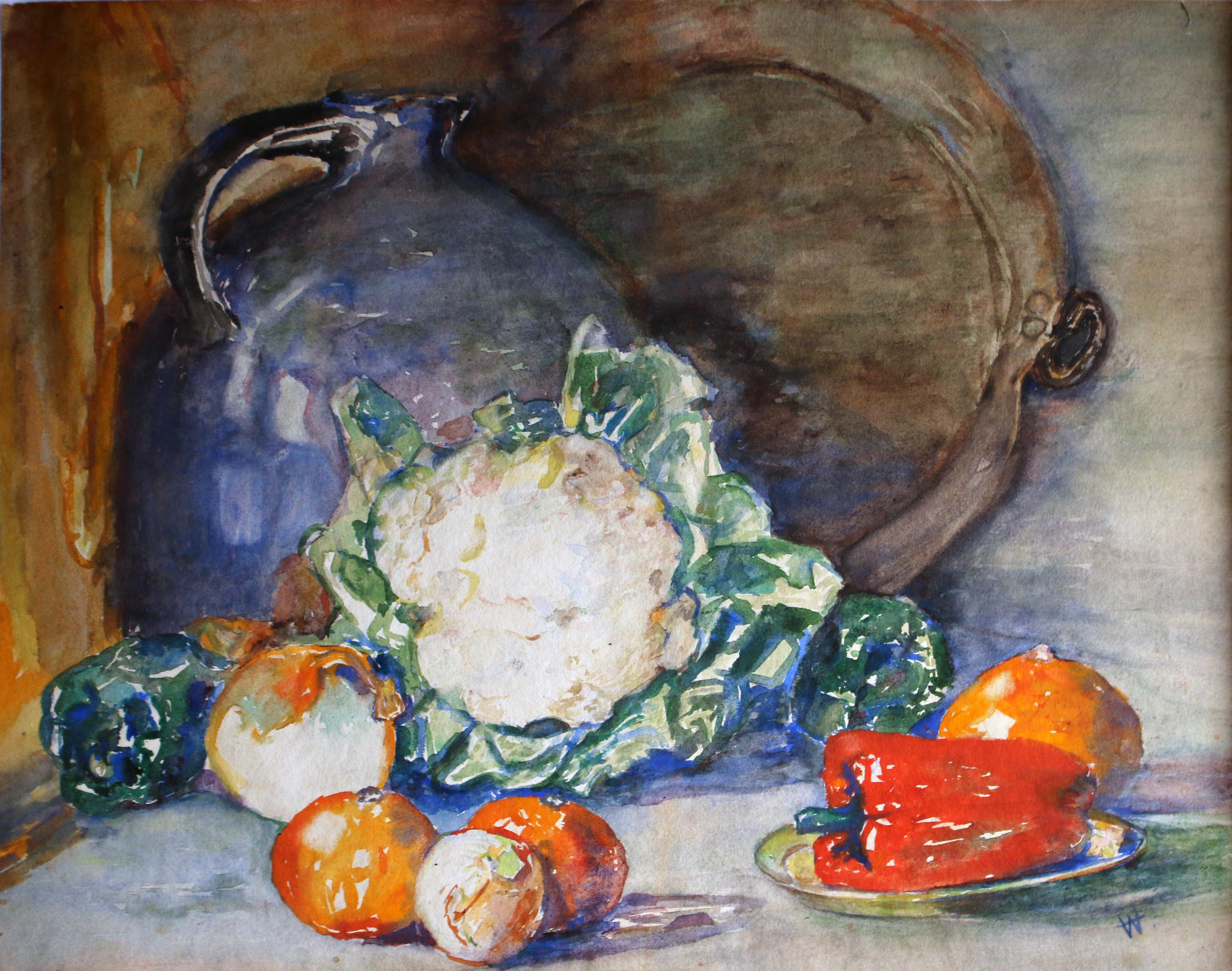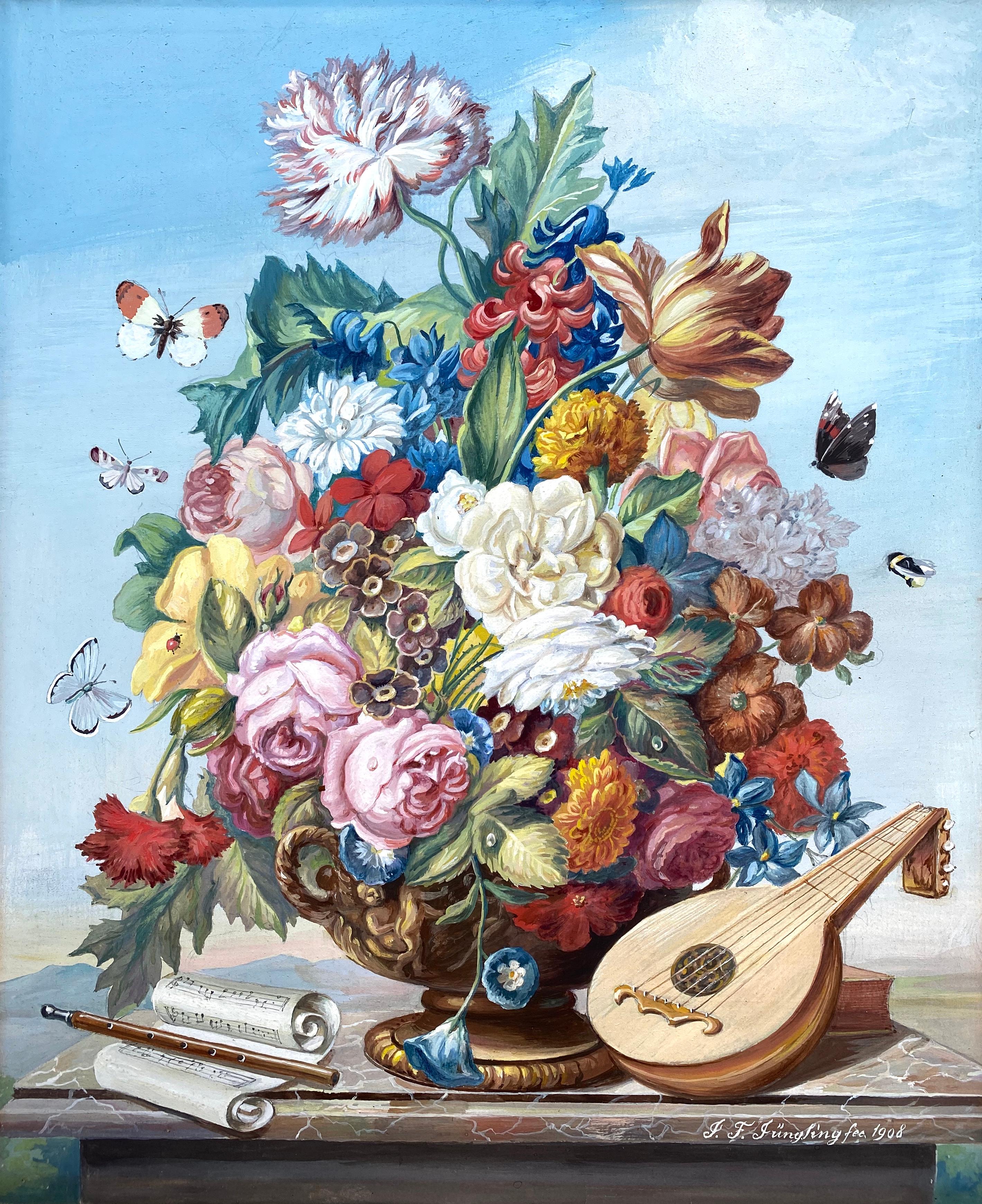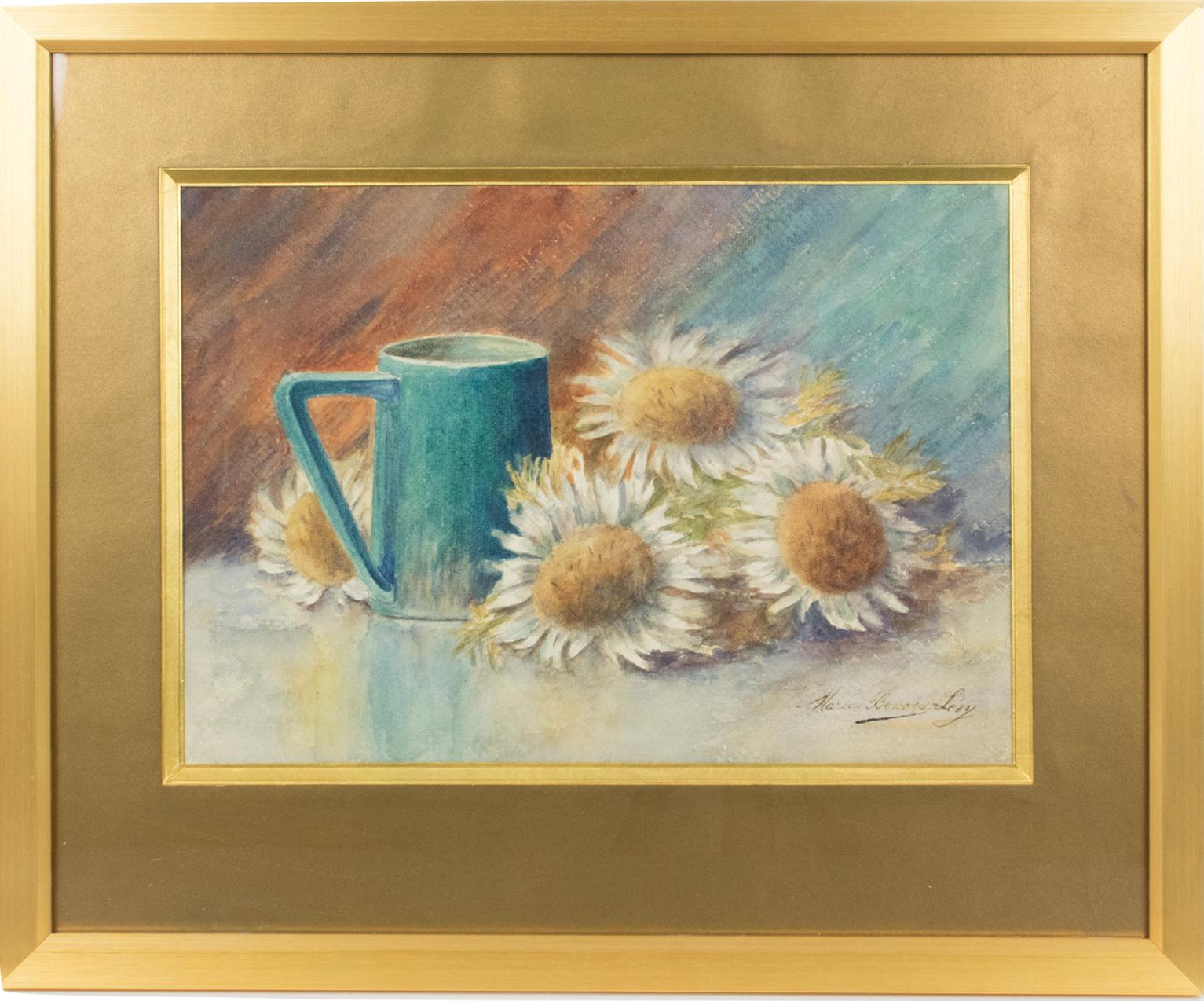Items Similar to "Daffodils in Ceramic Pitcher"
Want more images or videos?
Request additional images or videos from the seller
1 of 5
Unknown"Daffodils in Ceramic Pitcher"1903
1903
About the Item
Here for your consideration is a beautiful watercolor still life on heavy paper by the German artist, E. Riehle. Signed and dated lower right, 1903. In good condition with it's original linen matand elaborate gold leaf frame. Overall size framed is 25 by 18 inches.
- Creation Year:1903
- Dimensions:Height: 16.5 in (41.91 cm)Width: 9.5 in (24.13 cm)Depth: 1.5 in (3.81 cm)
- Medium:
- Movement & Style:
- Period:
- Condition:Good condition; original gold leaf frame.
- Gallery Location:Southampton, NY
- Reference Number:1stDibs: LU1411394803
About the Seller
5.0
Platinum Seller
These expertly vetted sellers are 1stDibs' most experienced sellers and are rated highest by our customers.
Established in 1977
1stDibs seller since 2013
468 sales on 1stDibs
Typical response time: 1 hour
- ShippingRetrieving quote...Ships From: Southampton, NY
- Return PolicyA return for this item may be initiated within 7 days of delivery.
More From This SellerView All
- “Floral Bouquet with Mandolin”Located in Southampton, NYBeautiful floral watercolor and gouache on paper with musical instruments by the German artist, Friedrich (Frederick) Jungling. Signed lower right and dated 1908. Excellent condition...Category
Early 1900s Academic Still-life Drawings and Watercolors
MaterialsWatercolor, Gouache, Archival Paper
- “Still Life with White Roses”Located in Southampton, NYBeautiful original watercolor by Jessie Harris Bone Charman. Signed lower right. Circa 1940. Condition is very good. Under glass. Beautifully matted and framed. Overall framed mea...Category
1940s Modern Still-life Drawings and Watercolors
MaterialsArchival Paper, Watercolor
- “Geraniums”Located in Southampton, NYVery well painted original watercolor on archival paper of potted geraniums with metal watering can and garden gloves. Signed in pencil by the artist Peggy Dressel lower right. The S...Category
1980s Contemporary Still-life Drawings and Watercolors
MaterialsWatercolor, Archival Paper
- “Spring Bouquet 2”By Rosalind OesterleLocated in Southampton, NYOriginal watercolor on archival paper by Rosalind Oesterle. Circa 1970. Signed lower left by the artist. Oval format. Condition is excellent. Profe...Category
1970s Contemporary Still-life Drawings and Watercolors
MaterialsArchival Paper, Watercolor
- “Spring Bouquet”By Rosalind OesterleLocated in Southampton, NYOriginal watercolor on archival paper by Rosalind Oesterle. Circa 1970. Signed lower left by the artist. Oval format. Condition is excellent. Profe...Category
1970s Contemporary Still-life Drawings and Watercolors
MaterialsArchival Paper, Watercolor
- “Roses and Pansies”Located in Southampton, NYVery well executed watercolor and gouache on heavy card stock of a spring bouquet composed of mainly roses and pansies. Unsigned. Circa 1915. Original gold painted wood frame. Under...Category
1910s Post-Impressionist Still-life Drawings and Watercolors
MaterialsWatercolor, Gouache, Cardboard
You May Also Like
- Untitled: Still Life with Cauliflower, Orange and PepperLocated in New York, NYUnidentified/ Unknown Artist, "Untitled: Still Life with Cauliflower, Orange and Pepper", Monogrammed Still Life Watercolor on Paper, 16 x 20, Late 20th Century Colors: Brown, Blue...Category
Late 20th Century Academic Still-life Drawings and Watercolors
MaterialsPaper, Watercolor
- 'The Old Oak Tree, Bushey School of Art, BritishLocated in Santa Cruz, CASigned lower right, 'Laurence Bell' (British, died 1916) and painted circa 1910. Bell studied at the Bushey School of Art in Hertfordshire in England. His preferred subject was land...Category
1890s Academic Landscape Drawings and Watercolors
MaterialsPaper, Gouache
- Still Life with Thistles Watercolor Painting by Marie Benoit-LevyLocated in Atlanta, GAMarie Benoit-Levy (France, 20th Century). This lovely watercolor on Arches Vellum paper painting features still-life with thistles and a blue water pot, an academic design by Marie B...Category
1930s Academic Still-life Paintings
MaterialsWatercolor
- Edouard Detaille (1848 1912), A trophy of arms, original signed DrawingBy Jean Baptiste Édouard DetailleLocated in Paris, FREdouard Detaille (1848-1912) A trophy of arms 11.5 x 20 cm Pen and ink with heightenings of white gouache on paper Signed and dated 1885 lower right and annotated "Armée française...Category
1880s Academic Figurative Drawings and Watercolors
MaterialsInk
- Garden FlowersBy Charles DemuthLocated in New York, NYCharles Demuth was one of the most complex, talented, and deeply sensitive artists of the American modern period. Whether he was painting floral still lifes, industrial landscapes, or Turkish bathhouses, art was, for Demuth, fraught with personal meaning. A fixture of the vanguard art scene in New York, Demuth navigated the currents of Modernism, producing some of the most exquisite watercolors and original oil paintings in twentieth-century American art. Demuth was born in Lancaster, Pennsylvania, the only child of a well-to-do family. He had an awkward and introverted childhood shaped by a childhood illness, Perthes, a disease of the hip that not only left him permanently lame, but, as part of the “cure,” bedridden for two years in the care of his mother. This long period of incapacitation had a deep impact on Demuth, who came to see himself as an invalid, an outsider who was different from everyone else. It was perhaps during this period of indoor confinement that his keen interest in art developed. Several relatives on his father’s side had been amateur artists, and, following his convalescence, his mother encouraged his artistic pursuits by sending him to a local painter for instruction. The majority of his early pictures are of flowers, a subject for which Demuth maintained a lifelong passion. Following high school, Demuth enrolled at the Drexel Institute of Art in Philadelphia, a school renowned for its commercial arts program. He advanced through the program rapidly, and, in 1905, at the encouragement of his instructors, he began taking courses at the Pennsylvania Academy of the Fine Arts. The two leading teachers then at the Academy were William Merritt Chase and Thomas Anshutz. Anshutz, himself a former student of Thomas Eakins, was well liked by his students, and is best known as the teacher of Robert Henri, John Sloan, and several of the other artists of the Ashcan School. Demuth, too, adopted a similar idiom, working in a controlled, realistic manner while at the Academy, where he remained until 1910. In 1907, Demuth made his first trip to Europe, staying in Paris. He spent time on the periphery of the art scene composed of the numerous American artists there, including John Marin and Edward Steichen. He returned to Philadelphia five months later, and immediately resumed courses at the Academy. Despite his introduction to advanced modern styles in Europe, Demuth’s work of this period retains the academic style he practiced before the trip. It wasn’t until he had summered at New Hope, Pennsylvania, in 1908 and 1911, that his style began to evolve. New Hope was a prominent American Impressionist art colony whose members were largely affiliated with the Pennsylvania Academy. Demuth dropped the conservative tone of his style and adopted a freer and more colorful palette. Although he remained based in Philadelphia, Demuth frequently went to New York during this period. Many of the same American artists of the Parisian art scene Demuth had encountered on his earlier European trip now formed the nucleus of New York’s avant-garde, which centered around Alfred Stieglitz’s 291 gallery. It wasn’t long before Demuth began to apply modernist-inspired strategies to his work. He was particularly influenced by the watercolor work of John Marin, also a former student of Anshutz, whose bold use of color in the medium Demuth freely adapted into looser washes of color. In 1912, Demuth again left for Paris, this time studying in the Académie Moderne, Académie Colorossi, and Académie Julian. In Paris Demuth met the American modernist Marsden Hartley. Hartley, a principal figure in the expatriate art circle, acted as a mentor to Demuth, and introduced him to the wide array of modern styles currently practiced in Europe. Hartley also introduced Demuth to many of the members of the Parisian avant-garde, including Gertrude Stein. Demuth was an aspiring writer, and he spent many hours in conversation with Stein. He wrote extensively during this period, and published two works shortly after his return to America. He also developed an interest in illustrating scenes from literary texts. From 1914 to 1919, Demuth produced a series of watercolors of scenes from books such as Emile Zola’s Nana and Henry James’s The Turn of the Screw. Upon his return to America, Demuth settled in New York. In 1914, Demuth had his first one-man show at Charles Daniel’s gallery, which promoted emerging modern American artists, including Man Ray, Rockwell Kent, Yasuo Kuniyoshi, Stuart Davis, and Max Weber. Demuth drew closer to the artistic vanguard in New York, becoming friends with many in the Stieglitz and Daniel circles, including Georgia O’Keeffe, Marcel Duchamp, Carl Van Vechten, and Edward Fiske. New York’s cosmopolitan atmosphere and active nightlife appealed greatly to Demuth. In a sketchy style well suited to watercolor, he painted many vaudeville and circus themes, as well as nightclub, café, and bathhouse scenes. Often with Duchamp, Demuth took part in an urban subculture replete with nightclubs, bars, drugs, and sexual permissiveness, which, for a homosexual artist like himself, allowed room for previously unattainable personal expression. Demuth’s pictures of sailors, bathhouses, and circus performers embody a sensual and sexual undercurrent, expressing the artist’s sense of comfort and belonging in the bohemian subculture of New York. Simultaneously, Demuth deepened his interest in floral pictures, painting these almost exclusively in watercolor. His style evolved from the broad color washes of his earlier pictures to more spare, flattened, and sinuous compositions, inspired by the drawings of Aubrey Beardsley and other artists of the Aesthetic Movement. Demuth’s flower watercolors are moody and atmospheric, sensuous and elegant, introspective and yet full of expressive power. Moreover they are beautiful, and are unequivocally among the finest still lifes in American art. Despite numerous subsequent artistic undertakings that led him in a variety of directions, Demuth never stopped painting flower pictures, ultimately adding fruits and other still-life objects to his repertoire. In 1916, Demuth began to develop a style later known as Precisionism, a form of landscape painting infused with Cubism, in which space is divided into precisely drawn geometric regions of color. Demuth first began to paint the landscape in an appropriated Cubist mode while on a trip with Hartley to Bermuda. In these early landscapes, in which the curvilinear forms of trees intersect the geometrically articulated architectural forms, Demuth explored ideas that shaped the future development of modernism in America. The full realization of Demuth’s explorations came after his return to America in 1917, when he turned his attention to industrial subjects. These works derive from a “machine aesthetic,” espoused by New York artists such as Francis Picabia, Joseph Stella, Albert Gleizes, and Duchamp, by which artists viewed machines as embodying mystical, almost religious significance as symbols of the modern world. Rather than painting the skyscrapers and bridges of New York as did most of his like-minded contemporaries, Demuth returned to his home town of Lancaster, where he painted factories and warehouses in a Precisionist idiom. The titles for these pictures are often contain literary references, which serve as clues for the viewer to aid in the decoding of the artist’s meaning. In 1923, Demuth planned a series of abstract “poster portraits” of his friends and contemporaries in the New York art and literary scene. In these “portraits,” Demuth combined text and symbolic elements to evoke the essential nature of his sitters’ distinguishing characteristics. In this fashion, he painted portraits of such artists as Georgia O’Keeffe, John Marin, and Arthur Dove. His most famous poster portrait, I Saw the Figure 5 in Gold...Category
20th Century American Modern Still-life Drawings and Watercolors
MaterialsPaper, Watercolor
- Swim, Summer Fresh Painting on Paper, Word Art Pastel Tones Typography in PurpleBy Ryan RivadeneyraLocated in Barcelona, ES"Swim is a hand-painted acrylic painting on high-quality 300g paper by artist Ryan Rivadeneyra. The hand-drawn render is reminiscent and inspired by the word art that Ed Ruscha produ...Category
2010s Pop Art Still-life Drawings and Watercolors
MaterialsInk, Archival Ink, Sumi Ink, Watercolor, Archival Paper, Acrylic
Recently Viewed
View AllMore Ways To Browse
Antique Gold Leaf Frame
German Artist Ceramic
Life Size Ceramic
Gold Pitcher
Antique Ceramic Pitchers
Antique Ceramic Pitcher
Black Ceramic Pitcher
Antique German Linens
Daffodil Painting
Antique German Pitcher
Antique Pitcher Germany
Antique German Pitchers
Antique Daffodils
Antique Pitcher Frames
Gold Ceramic Pitcher
Antique German Ceramic Pitchers
Watercolor And Gouache Botanical Painting
Peony Watercolor





